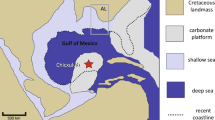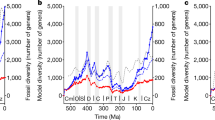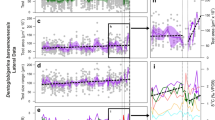Abstract
By compiling large databases and searching for environmental and palaeobiological correlates associated with survival, insight can be gained into the driving mechanisms involved in mass extinctions1,2,3,4. Although this approach lacks precise temporal resolution and thus cannot be used to investigate how rapidly extinction took place, it provides a broad overview, less plagued by sampling problems caused by shifting facies. Here we present a global analysis of a major marine invertebrate group, the sea urchins, which suffered 36% extinction at genus level in the late Maastrichtian age and continuing high levels of extinction in the Danian age. No preferential survivorship was found for clades with widespread distribution, but there was a strong correlation between feeding strategy and survivorship at the end of the Cretaceous period. Surprisingly, however, clades whose larvae must feed to reach metamorphosis were not significantly harder hit than those with non-feeding larval development. Our results indicate that nutrient supply was a crucial factor in driving K/T-boundary extinctions, with selection more strongly focused on benthic adult than on larval planktotrophic stages.
This is a preview of subscription content, access via your institution
Access options
Subscribe to this journal
Receive 51 print issues and online access
$199.00 per year
only $3.90 per issue
Buy this article
- Purchase on Springer Link
- Instant access to full article PDF
Prices may be subject to local taxes which are calculated during checkout



Similar content being viewed by others
References
Jablonski, D. Mass extinctions: persistent problems and new directions. Geol. Soc. Am. Spec. Pap. 307, 1–9 (1996).
Jablonski, D. in Dynamics of Extinction (ed. Elliott, D. K.) 183–229 (Wiley, New York, (1986)).
Jablonski, D. & Raup, D. M. Selectivity of end-Cretaceous marine bivalve extinction. Science 268, 389–391 (1995).
Jablonski, D. Progress at the K–T boundary. Nature 387, 354–355 (1997).
Smith, A. B. & Jeffery, C. H. Fossil echinoids of the Maastrichtian and Palaeocene: an illustrated key. Spec. Pap. Palaeont. (submitted).
Sheehan, P. M., Coorough, P. J. & Fastovsky, D. E. Biotic selectivity during the K/T and late Ordovician extinction events. Geol. Soc. Am. Spec. Pap. 307, 477–489 (1996).
Johansen, M. B. Background extinction and mass extinction of the brachiopods from the chalk of northwest Europe. Palaios 4, 243–250 (1989).
De Ridder, C. & Lawrence, J. M. in Echinoderm Nutrition (eds Jangoux, M. & Lawrence, J. M.) (Balkema, Rotterdam, (1982)).
Smith, A. B. The structure, function and evolution of tube feet and ambulacral pores in irregular echinoids. Palaeontology 23, 39–83 (1980).
Telford, M. & Mooi, R. Podial particle picking in Cassidulus caribaearum (Echinodermata: Echinoidea) and the phylogeny of sea urchin feeding mechanism. Biol. Bull. 191, 209–223 (1996).
Rose, E. P. F. Some observations on the recent holectypoid echinoid Echinoneus cyclostomus and their palaeoecological significance. Thalass. Jugoslav. 12, 299–306 (1978).
Valentine, J. W. & Jablonski, D. Mass extinctions: sensitivity of marine larval types. Proc. Natl Acad. Sci. USA 83, 6912–6914 ((1986)).
Levinton, J. S. Trophic group and the end-Cretaceous extinction: did deposit feeders have it made in the shade? Paleobiology 22, 104–112 ((1996)).
Summerhayes, C. P. & Thorpe, S. A. Oceanography, an Illustrated Guide (Manson, London, (1996)).
Barrera, E. Global environmental change preceding the Cretaceous–Tertiary boundary: Early–late Maastrichtian transition. Geology 22, 877–880 (1994).
Macleod, N. et al. The Cretaceous–Tertiary biotic transition. J. Geol. Soc. Lond. 154, 265–292 (1997).
Jeffery, C. H. Dawn of echinoid nonplanktotrophy: coordinated shifts in development indicate environmental instability prior to the K–T boundary. Geology 25, 991–994 (1997).
D'Hondt, S., Herbert, T. D., King, J. & Gibson, C. Planktonic foraminifera, asteroids, and marine production: death and recovery at the Cretaceous–Tertiary boundary. Geol. Soc. Am. Spec. Pap. 307, 303–317 (1996).
Acknowledgements
We thank M. Foote, J. Young, C. Marshall, P. Ward and J. Levinton for their comments on this paper. Research was supported by a NERC research grant.
Author information
Authors and Affiliations
Corresponding author
Rights and permissions
About this article
Cite this article
Smith, A., Jeffery, C. Selectivity of extinction among sea urchins at the end of the Cretaceous period. Nature 392, 69–71 (1998). https://doi.org/10.1038/32155
Received:
Accepted:
Issue Date:
DOI: https://doi.org/10.1038/32155
This article is cited by
-
Elevated Extinction Rates as a Trigger for Diversification Rate Shifts: Early Amniotes as a Case Study
Scientific Reports (2015)
-
Bivalve network reveals latitudinal selectivity gradient at the end-Cretaceous mass extinction
Scientific Reports (2013)
-
Embryonic, larval, and post-metamorphic development of the sea urchin Cassidulus mitis (Echinoidea; Cassiduloida): an endemic brooding species from Rio de Janeiro, Brazil
Marine Biology (2011)
-
Mass extinction probed
Nature (1998)
-
Switch from specialized to generalized pollination
Nature (1998)
Comments
By submitting a comment you agree to abide by our Terms and Community Guidelines. If you find something abusive or that does not comply with our terms or guidelines please flag it as inappropriate.



